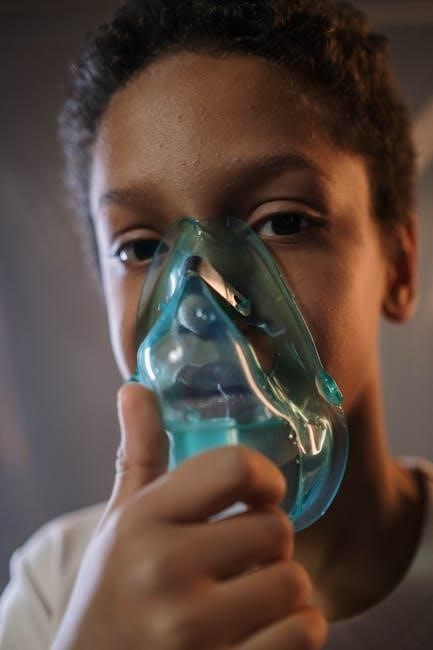Pediatric Advanced Life Support (PALS) is a critical care approach for managing life-threatening emergencies in children. It focuses on advanced techniques to stabilize and support pediatric patients during cardiac arrest and other critical conditions.
1.1. Definition and Scope of PALS
Pediatric Advanced Life Support (PALS) is a specialized medical approach designed to manage life-threatening conditions in infants and children. It focuses on advanced techniques to stabilize and support critically ill pediatric patients. The scope of PALS includes assessment, recognition, and intervention for conditions such as cardiac arrest, respiratory failure, and shock. It integrates basic life support with advanced care strategies, emphasizing high-quality CPR, effective ventilation, and timely interventions. PALS is tailored to the unique physiological and anatomical needs of pediatric patients, ensuring evidence-based care. This comprehensive approach is essential for healthcare providers to improve outcomes in critically ill children.
1.2. Importance of PALS in Pediatric Care
Pediatric Advanced Life Support (PALS) plays a critical role in improving outcomes for critically ill children. It ensures healthcare providers are equipped with the skills to manage life-threatening conditions effectively. PALS emphasizes early recognition and intervention, reducing morbidity and mortality in pediatric emergencies. By integrating evidence-based guidelines, PALS enhances the quality of care during cardiac arrest, respiratory distress, and shock. It also fosters a team-based approach, promoting effective communication and coordination among healthcare professionals. The implementation of PALS protocols has been shown to improve survival rates and long-term neurological outcomes in pediatric patients, making it an essential component of modern pediatric care.

Key Concepts and Algorithms in PALS
Pediatric Advanced Life Support (PALS) relies on evidence-based algorithms and systematic approaches to manage cardiac arrest and critical conditions in children, ensuring timely and effective care.
2.1. Pediatric Assessment and Recognition of Cardiac Arrest
Pediatric assessment is critical for early recognition of cardiac arrest. Healthcare providers must quickly identify signs such as unresponsiveness, lack of breathing, or poor circulation. In children, cardiac arrest often presents subtly, with gradual deterioration rather than sudden collapse. The ABC (Airway, Breathing, Circulation) approach is essential, with a focus on pediatric-specific criteria. Monitoring tools like ECG and pulse oximetry aid in early detection of arrhythmias or hypoxia. Prompt recognition allows for timely intervention, improving outcomes. Understanding age-specific norms and clinical signs is vital for accurate assessment and effective management of pediatric cardiac emergencies.
2.2. PALS Algorithms for Cardiac Arrest Management

PALS algorithms provide a systematic approach to managing pediatric cardiac arrest. They emphasize high-quality CPR, prompt defibrillation, and administration of medications like epinephrine. The algorithms are tailored to pediatric physiology, ensuring interventions are age-appropriate. Continuous monitoring and adjustments are crucial to optimize outcomes. These guidelines also include post-arrest care to prevent further complications. Adherence to PALS algorithms ensures standardized and effective management, improving the likelihood of successful resuscitation and recovery in children experiencing cardiac arrest.
2.3. Role of Teamwork in PALS
Teamwork is essential in Pediatric Advanced Life Support (PALS) as it ensures coordinated and effective patient care during emergencies. Clear communication and defined roles within the team enhance decision-making and minimize errors. Each member, from nurses to physicians, contributes unique skills, fostering a collaborative environment. Leadership is crucial to guide interventions and maintain focus. Continuous training and simulation drills improve team dynamics, ensuring seamless coordination. Effective teamwork directly impacts patient outcomes, making it a cornerstone of successful PALS implementation. Collaboration among healthcare providers is vital to providing comprehensive and timely care, ultimately improving the chances of successful resuscitation and recovery in critically ill children.

Airway Management in PALS
Airway management in PALS involves advanced techniques to ensure patent airways in critically ill children, focusing on safety and effectiveness according to guidelines.
3.1. Techniques for Pediatric Airway Management
Pediatric airway management requires precision and skill to ensure effective oxygenation and ventilation. Techniques include bag-mask ventilation, endotracheal intubation, and laryngeal mask airway placement. Proper sizing of equipment is crucial, as pediatric airways are smaller and more delicate. Pre-intubation preparation, such as pre-oxygenation and use of appropriate medications, is essential to minimize complications. The choice of technique depends on the patient’s age, condition, and the provider’s expertise. Continuous training and adherence to guidelines are vital to master these life-saving skills in pediatric care.
3.2. Use of Endotracheal Tubes and Ventilators
The use of endotracheal tubes (ETTs) and ventilators is a cornerstone of pediatric airway management. Proper sizing and placement of ETTs are critical to ensure effective ventilation and prevent complications. Ventilators are adjusted to deliver appropriate tidal volumes and respiratory rates tailored to the child’s age and condition. Use of cuffed ETTs is recommended for children over 1 year to minimize leaks. Ventilator modes such as SIMV (synchronized intermittent mandatory ventilation) and AC (assist-control) are commonly employed. Close monitoring of end-tidal CO2, oxygen saturation, and lung mechanics ensures optimal ventilation and minimizes barotrauma.
3.3. Monitoring and Maintenance of Airway Patency
Monitoring and maintenance of airway patency are critical in PALS to ensure effective ventilation. Clinical assessment includes auscultation of breath sounds and visualization of chest rise. Pulse oximetry and capnometry provide real-time feedback on oxygenation and ventilation. Regular suctioning of endotracheal tubes prevents secretion accumulation, while humidified oxygen helps maintain mucosal integrity. Adjusting the patient’s position and ensuring proper ETT placement are vital. Continuous vigilance and timely interventions by the healthcare team prevent complications, optimizing patient outcomes and ensuring the child’s safety during critical care.

Ventilation and Oxygenation in PALS

Ventilation and oxygenation are essential in PALS, focusing on strategies to optimize breathing and maintain adequate oxygen levels in critically ill children.
4.1. Strategies for Effective Ventilation
Effective ventilation in PALS involves assessment-driven strategies to ensure adequate gas exchange and prevent complications. Techniques include bag-mask ventilation, endotracheal intubation, and mechanical ventilation. Proper sizing of equipment, such as endotracheal tubes and masks, is crucial to minimize discomfort and complications. Continuous monitoring of respiratory parameters, including tidal volume and respiratory rate, helps optimize ventilation. Adjuncts like positive end-expiratory pressure (PEEP) may be used to improve oxygenation. Regular reassessment ensures that ventilation strategies are tailored to the child’s evolving needs, promoting lung protection and preventing iatrogenic injury. These strategies are critical for maintaining respiratory stability in critically ill pediatric patients.
4.2. Oxygenation Targets in Critically Ill Children
Oxygenation targets in critically ill children focus on maintaining optimal blood oxygen levels to prevent hypoxia and oxidative stress. The goal is to achieve an SpO2 of 94-100% in most pediatric patients. However, targets may vary based on underlying conditions, such as chronic lung disease or congenital heart defects. Continuous monitoring with pulse oximetry is essential to guide oxygen therapy. Adjustments in FiO2 and ventilator settings should be made cautiously to avoid hyperoxia, which can cause lung injury. Individualized oxygenation strategies are critical to balance adequate tissue oxygenation with the risks of excessive oxygen exposure, ensuring the best outcomes for pediatric patients.

Pharmacology in PALS
Pharmacology in PALS involves the use of medications such as epinephrine, atropine, and amiodarone to manage cardiac arrest and arrhythmias, with precise dosing based on patient weight and age.
5.1. Medications Commonly Used in PALS
In PALS, medications like epinephrine, atropine, amiodarone, and lidocaine are frequently administered to manage cardiac arrest and arrhythmias. Epinephrine is the primary vasopressor used to restore cardiac function, while atropine is employed to regulate heart rate. Amiodarone and lidocaine are essential for controlling ventricular fibrillation and tachycardia. Additionally, medications such as naloxone and glucose are used to address specific conditions like opioid overdose or hypoglycemia. Proper dosing and timing are critical to ensure efficacy and minimize adverse effects; These pharmacological interventions are tailored to the pediatric patient’s weight and condition, emphasizing precision in administration to optimize outcomes during critical care scenarios.

5.2. Dosing Considerations for Pediatric Patients
Dosing in pediatric advanced life support requires precise calculation based on the patient’s weight in kilograms. Using a PALS medication chart or calculator ensures accurate dosages, minimizing errors. Weight-based dosing is critical to avoid underdosing or overdosing, which can lead to severe complications. Dilution guidelines must be followed to adjust concentrations appropriately for pediatric patients. Administration techniques, such as using syringe pumps, are essential for accurate delivery, especially in infants. Continuous monitoring of the patient’s response allows for timely adjustments, ensuring safe and effective treatment. Adherence to these guidelines is vital for optimal outcomes in critically ill children.

Post-Cardiac Arrest Care in PALS
Post-cardiac arrest care in PALS focuses on neuroprotection, temperature regulation, and supportive therapies to optimize recovery and minimize complications in critically ill children. Early intervention is crucial.
6.1. Temperature Management and Neuroprotection
Temperature management and neuroprotection are vital in post-cardiac arrest care for pediatric patients. Targeted temperature management, such as mild hypothermia, is often used to reduce brain injury risk. Monitoring brain activity and oxygenation is essential. Maintaining normothermia and avoiding hyperthermia are critical to prevent further neurological damage. Neuroprotective strategies may include sedation, seizure control, and optimizing cerebral perfusion. These interventions aim to minimize secondary brain insults and improve neurological outcomes. Early and consistent implementation of these measures is associated with better recovery rates in children post-cardiac arrest. Close monitoring and individualized care plans are necessary to ensure effective neuroprotection and temperature control.
6.2. Supportive Care After Cardiac Arrest
Supportive care after cardiac arrest in pediatric patients focuses on optimizing recovery and minimizing complications. This includes hemodynamic support to ensure adequate blood flow to vital organs, managing electrolytes, and correcting acid-base imbalances. Pain and sedation management are critical to prevent distress and promote comfort. Nutritional support is initiated early to aid recovery. Family-centered care is emphasized to provide emotional and psychological support during the recovery process. Close monitoring of vital signs and organ function is essential to address any emerging issues promptly. A multidisciplinary approach ensures comprehensive care tailored to the child’s needs, improving outcomes and quality of life post-arrest.
Pediatric Advanced Life Support (PALS) is crucial for managing life-threatening emergencies in children. It integrates advanced techniques, teamwork, and evidence-based care to improve outcomes and save lives effectively.
7;1. Summary of Key Takeaways
Pediatric Advanced Life Support (PALS) emphasizes a systematic approach to managing critically ill children. Key takeaways include the importance of rapid assessment, effective resuscitation techniques, and evidence-based interventions. Proper airway management, ventilation strategies, and pharmacological interventions are critical. Teamwork and communication play a vital role in improving patient outcomes. Continuous learning and adherence to updated guidelines ensure optimal care. PALS training equips healthcare providers with the skills to handle pediatric emergencies confidently, ultimately saving lives and reducing long-term complications. By integrating these principles, PALS serves as a cornerstone in pediatric emergency care, fostering better clinical decision-making and improved patient survival rates.
7.2. Importance of Continuous Learning in PALS
Continuous learning is essential in Pediatric Advanced Life Support (PALS) to stay updated with evolving medical guidelines and evidence-based practices. Healthcare providers must commit to lifelong learning to maintain proficiency in managing critically ill children. Advances in pediatric care, such as new medications and resuscitation techniques, require ongoing education to ensure optimal patient outcomes. Regular training and recertification in PALS help providers adapt to emerging challenges and improve their decision-making skills. By staying informed, professionals can deliver high-quality, life-saving care and remain competent in high-stakes situations, ultimately enhancing patient survival and reducing complications.